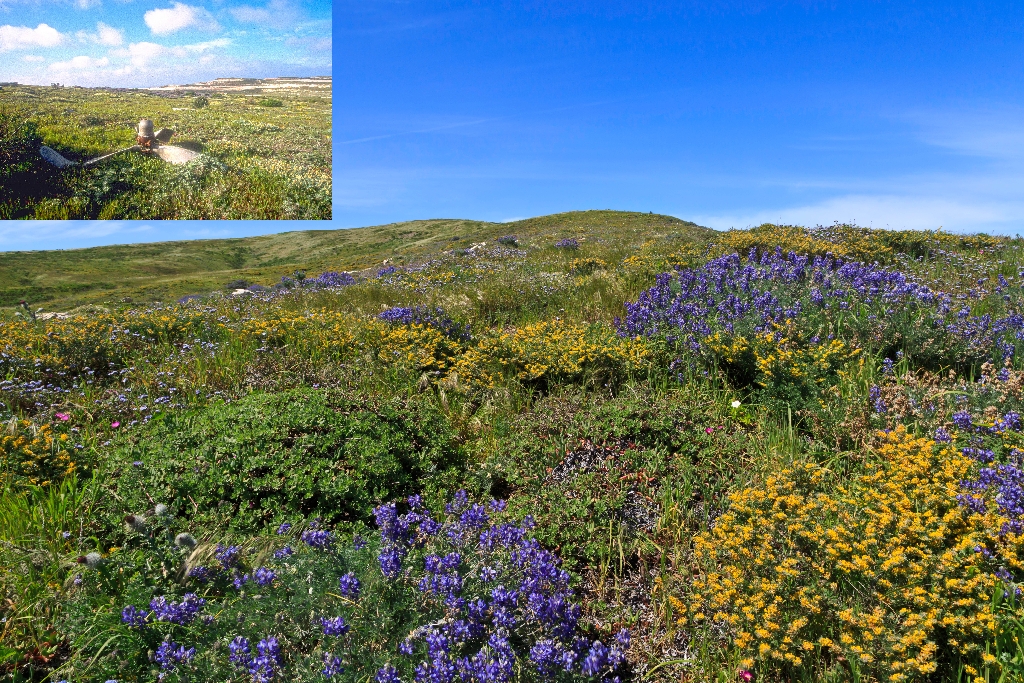
Due to unexploded ordnance, visitors must be accompanied by a ranger to this location. Entering this area without a ranger is a violation of federal law.
Near the 817 foot tall Green Mountain, lies the wreckage of the B-24 Liberator bomber. On July 5, 1943, the B-24 bomber crashed on the north side of Green Mountain, killing all 12 men aboard. The "Liberator" was part of a fleet of new bombers that eventually numbered 18,000. The air armed forces used dozens of Liberators for training, using mostly young and inexperienced crews, which led to numerous crashes. "It had a long, thin, high lift wing which made it suitable for long distance bombing missions . . . generally it was not regarded as the safest aircraft in the sky," wrote crash historian R. W. Koch. "Yet, it played a major role in helping to win the war in Europe and Asia." The 56,000-pound planes were equipped with four 1,200 horsepower engines, had a maximum speed of 303 mph and a range of 3,200 miles. The B-24-E Liberator in question was built by the Ford Motor Company in Michigan and was new; its personnel was assigned to the 2nd Air Force, 34th Bomb Group, 7th Bomb Squadron at Salinas Army Air Base in Salinas.
The plane, with a crew of 12 aboard, had been searching for ten crew members of another B-24 that had crashed near Santa Barbara the day before after the crew had bailed out somewhere near the coast. The search plane left Bakersfield towards Santa Barbara, and was to continue to Point Conception and Salinas, but disappeared after reporting over Santa Barbara at 8:00 a.m. Evidently, the B-24 flew too low in foggy conditions while approaching Point Conception; the ceiling that day was 300 to 500 feet and the plane had no radar. The bomber struck the side of 831-foot Green Mountain and practically disintegrated, killing all aboard and spreading wreckage over an area of up to ten acres. Although the crash site was only a short distance from the Coastal Lookout Station, it was at least two miles from the barracks and no one heard the impact and no one saw the wreckage.
Robert Brooks came on the wreckage some time later when he was gathering sheep near Green Mountain, although government records state that sailors based at the island's radio/weather station found it on March 19, 1944. Whatever the date, the late discovery reflected on the diligence and state of readiness at this lookout station at the time of the crash. Stan Sokolis and Robert McKee, stationed on the island radio unit, reportedly assisted in the task of removing the bodies and salvaging important plane parts, although much of the scattered wreck was left on the site.
In 1954 some hikers found the wreckage and human bones. Authorities were notified who could not find a record of the wreck; they dispatched an investigation team on a Coast Guard cutter in the night. Unfortunately, the cutter collided in the darkness with the yacht Aloha off Point Mugu, killing two aboard. After rescuing three survivors the cutter returned to Los Angeles, then again commenced its mission to San Miguel Island. There they found the wreckage but soon received a radio message stating that records of the wreck had been located and that the investigation was off.
Is there something we missed for this itinerary?
Itineraries across USA


















































